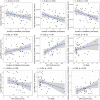Association between brain health outcomes and metabolic risk factors in persons with diabetes
- PMID: 37518982
- PMCID: PMC10578900
- DOI: 10.1002/acn3.51859
Association between brain health outcomes and metabolic risk factors in persons with diabetes
Abstract
We performed a cross-sectional study to determine associations between cognition and MRI-derived brain outcomes, with obesity, diabetes duration, and metabolic risk factors in 51 Pima American Indians with longstanding type 2 diabetes (T2d) (mean [SD] age: 48.4 [11.3] years, T2d duration: 20.1 [9.1] years). Participants had similar cognition (NIH Toolbox Cognition Battery composite: 45.3 [9.8], p = 0.64, n = 51) compared to normative data. T2d duration, but not other metabolic risk factors, associated with decreased cortical thickness (Point Estimate (PE): -0.0061, 95%CI: -0.0113, -0.0009, n = 45), gray matter volume (PE: -830.39, 95%CI: -1503.14, -157.64, n = 45), and increased white matter hyperintensity volume (PE: 0.0389, 95%CI: 0.0049, 0.0729, n = 45).
© 2023 The Authors. Annals of Clinical and Translational Neurology published by Wiley Periodicals LLC on behalf of American Neurological Association. This article has been contributed to by U.S. Government employees and their work is in the public domain in the USA.
Conflict of interest statement
Dr. Reynolds reports no disclosures. Dr. Votruba reports no disclosures. Dr Jack has consulted and served on data safety and monitoring boards but receives no financial compensation from any commercial entity. Dr. Beare reports no disclosures. Dr. Reid reports no disclosures. Mr. Preboske reports no disclosures. Ms. Waseta reports no disclosures. Dr. Pop‐Busui receives research support from Novo Nordisk. Dr. Nelson reports no disclosures. Dr. Callaghan consults for DynaMed, receives research support from the American Academy of Neurology and performs medical legal consultations including consultations for the Vaccine Injury Compensation Program. Dr. Feldman reports no disclosures.
Figures

Similar articles
-
The determinants of complication trajectories in American Indians with type 2 diabetes.JCI Insight. 2021 May 24;6(10):e146849. doi: 10.1172/jci.insight.146849. JCI Insight. 2021. PMID: 34027894 Free PMC article.
-
Analysis of the relationships between type 2 diabetes status, glycemic control, and neuroimaging measures in the Diabetes Heart Study Mind.Acta Diabetol. 2016 Jun;53(3):439-47. doi: 10.1007/s00592-015-0815-z. Epub 2015 Nov 2. Acta Diabetol. 2016. PMID: 26525870 Free PMC article.
-
Associations Between the Dietary Inflammatory Index, Brain Volume, Small Vessel Disease, and Global Cognitive Function.J Acad Nutr Diet. 2021 May;121(5):915-924.e3. doi: 10.1016/j.jand.2020.11.004. Epub 2020 Dec 15. J Acad Nutr Diet. 2021. PMID: 33339764
-
Abdominal Obesity and Brain Atrophy in Type 2 Diabetes Mellitus.PLoS One. 2015 Nov 11;10(11):e0142589. doi: 10.1371/journal.pone.0142589. eCollection 2015. PLoS One. 2015. PMID: 26560876 Free PMC article.
-
[Non-insulin-dependent diabetes in populations at risk: the Pima Indians].Diabetes Metab. 1997 Nov;23 Suppl 4:6-9. Diabetes Metab. 1997. PMID: 9463026 Review. French.
Cited by
-
Association of carotid atherosclerosis with brain tissue integrity and metabolic parameters in type 2 diabetes patients.Front Endocrinol (Lausanne). 2025 Aug 1;16:1586085. doi: 10.3389/fendo.2025.1586085. eCollection 2025. Front Endocrinol (Lausanne). 2025. PMID: 40822944 Free PMC article.
-
A systematic review of the impact of type 2 diabetes on brain cortical thickness.Front Dement. 2024 Jun 13;3:1418037. doi: 10.3389/frdem.2024.1418037. eCollection 2024. Front Dement. 2024. PMID: 39081608 Free PMC article.
References
-
- NCD Risk Factor Collaboration (NCD‐RisC) . Worldwide trends in body‐mass index, underweight, overweight, and obesity from 1975 to 2016: a pooled analysis of 2416 population‐based measurement studies in 128·9 million children, adolescents, and adults. Lancet. 2017;390(10113):2627‐2642. - PMC - PubMed
-
- Xue M, Xu W, Ou Y‐N, et al. Diabetes mellitus and risks of cognitive impairment and dementia: a systematic review and meta‐analysis of 144 prospective studies. Ageing Res Rev. 2019;55:100944. - PubMed
-
- Qu Y, Hu H‐Y, Ou Y‐N, et al. Association of body mass index with risk of cognitive impairment and dementia: a systematic review and meta‐analysis of prospective studies. Neurosci Biobehav Rev. 2020;115:189‐198. - PubMed
Publication types
MeSH terms
Grants and funding
- P30 DK092926/DK/NIDDK NIH HHS/United States
- U24 DK115255/DK/NIDDK NIH HHS/United States
- R01 DK115687/DK/NIDDK NIH HHS/United States
- R00 DK129785/DK/NIDDK NIH HHS/United States
- R01 DK130913/DK/NIDDK NIH HHS/United States
- R01 DK107956/DK/NIDDK NIH HHS/United States
- 1U01 DK0945157/DK/NIDDK NIH HHS/United States
- P30 DK020572/DK/NIDDK NIH HHS/United States
- K99 DK129785/DK/NIDDK NIH HHS/United States
- U01 AG057562/AG/NIA NIH HHS/United States
- R01 DK116723/DK/NIDDK NIH HHS/United States
- U01 DK119083/DK/NIDDK NIH HHS/United States
LinkOut - more resources
Full Text Sources
Medical
